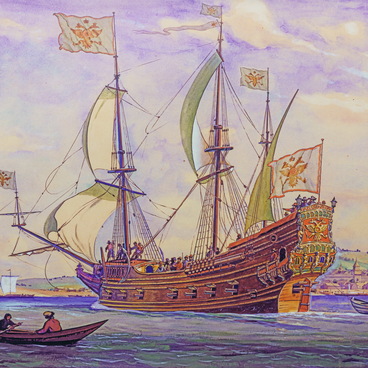In July 1701, during the Great Northern War, a Swedish squadron led by the commander Carl Henrik von Löwe sailed to the White Sea. It intended to destroy Arkhangelsk — Russia’s only sea port at the time which was responsible for trading with Europe, as well as the admiralty shipyards in Solombala, and the warships that were being built there.
Swedish ships approached the Dvina estuary in Arkhangelsk and disguised as merchant ships attempted to enter the port. However, the monastery server Ivan Ryabov and the boatman Dmitry Borisov, captured by the Swedes to find out the route for approaching the city, managed to disrupt the enemy’s plans. While tied in a cable chain locker, the Russian heroes discussed how they could prevent the enemy from passing unobserved along the river’s fairway.
Ivan Ryabov was an experienced marine pilot. He had navigated many merchant ships from various lands along the capricious river. This time, an enemy was sailing toward his homeland. Ryabov crossed himself and stood beside the helmsman, preparing his audacious plan. He understood from the conversations with the Swedes, that they did not know that “city planners and various architects” had been building bastions on the riverbank day and night for a year. And although the construction of the fortress had not been completed yet, cannoneers were in full combat readiness. When a launch with Russian soldiers sailed from the fortress to check the foreign ships, the Swedish soldiers hid, while the officers switched their uniforms for caftans. Having approached the Swedish vessels, the Russians noticed the deception and started firing. Ryabov and Borisov stranded the two ships, while the third one managed to turn. Borisov was killed, while Ryabov was seriously wounded and thrown overboard by the Swedes. He called up all his strength and swam to the city.
The fortress was firing one cannon ball after another. Dozens of large boats with soldiers rushed to the enemy. After a 13-hour exchange of fire, both vessels were captured, set afloat, and triumphantly brought to Arkhangelsk. Tsar Peter the Great wrote,
Swedish ships approached the Dvina estuary in Arkhangelsk and disguised as merchant ships attempted to enter the port. However, the monastery server Ivan Ryabov and the boatman Dmitry Borisov, captured by the Swedes to find out the route for approaching the city, managed to disrupt the enemy’s plans. While tied in a cable chain locker, the Russian heroes discussed how they could prevent the enemy from passing unobserved along the river’s fairway.
Ivan Ryabov was an experienced marine pilot. He had navigated many merchant ships from various lands along the capricious river. This time, an enemy was sailing toward his homeland. Ryabov crossed himself and stood beside the helmsman, preparing his audacious plan. He understood from the conversations with the Swedes, that they did not know that “city planners and various architects” had been building bastions on the riverbank day and night for a year. And although the construction of the fortress had not been completed yet, cannoneers were in full combat readiness. When a launch with Russian soldiers sailed from the fortress to check the foreign ships, the Swedish soldiers hid, while the officers switched their uniforms for caftans. Having approached the Swedish vessels, the Russians noticed the deception and started firing. Ryabov and Borisov stranded the two ships, while the third one managed to turn. Borisov was killed, while Ryabov was seriously wounded and thrown overboard by the Swedes. He called up all his strength and swam to the city.
The fortress was firing one cannon ball after another. Dozens of large boats with soldiers rushed to the enemy. After a 13-hour exchange of fire, both vessels were captured, set afloat, and triumphantly brought to Arkhangelsk. Tsar Peter the Great wrote,



